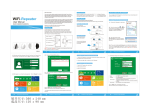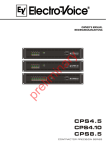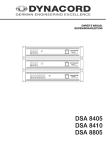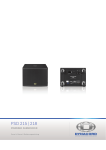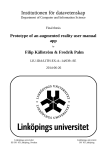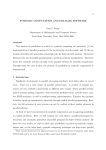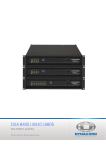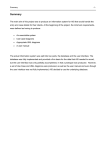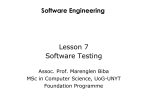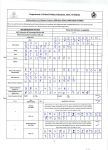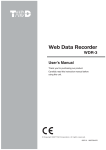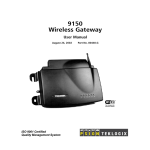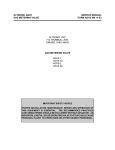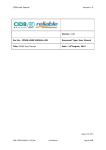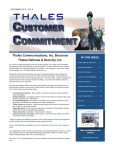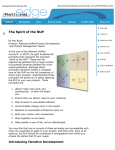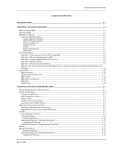Download daimler
Transcript
15-413 Handout 2 29 August 1995 15-413 Software Engineering Carnegie Mellon University School of Computer Science Bernd Bruegge The DAIMLER System Problem Statement Table of Contents 1. 1. INTRODUCTION ................................................................................................................................................3 1.1 OVERVIEW .................................................................................................................................................................3 1.2 PREVENTIVE MAINTENANCE......................................................................................................................................3 1.3 CHANGE MANAGEMENT ............................................................................................................................................3 1.4 DIAGNOSTICS .............................................................................................................................................................4 2. REQUIREMENTS....................................................................................................................................................4 2.1 FUNCTIONAL REQUIREMENTS ....................................................................................................................................4 2.1.1 Preventive Maintenance....................................................................................................................................4 2.1.2 Change Management ........................................................................................................................................5 2.1.3 Diagnostics........................................................................................................................................................6 2.1.4 Functionality provided by DAIMLER ...............................................................................................................7 2.2 GLOBAL REQUIREMENTS ...........................................................................................................................................7 2.2.1 Development Environment ................................................................................................................................8 2.2.2 Target Environment ..........................................................................................................................................8 2.2.3 Target Platform.................................................................................................................................................8 3. DESIGN ISSUES ......................................................................................................................................................8 3.1 CLIENT SUBSYSTEMS .................................................................................................................................................9 3.1.1 Preventive Maintenance....................................................................................................................................9 3.1.2 Change Management ........................................................................................................................................9 3.1.3 Diagnostics......................................................................................................................................................10 3.2 SERVER SUBSYSTEMS ..............................................................................................................................................10 3.2.1 Notification Server ..........................................................................................................................................10 3.2.2 Visualization Server ........................................................................................................................................10 3.2.3 ATGS Data Server...........................................................................................................................................10 3.2.4 Communication Server....................................................................................................................................10 1 3.2.5 Database Server ..............................................................................................................................................10 3.2.6 Information Space ...........................................................................................................................................10 3.2.7 System Manager ..............................................................................................................................................11 4. CLIENT ACCEPTANCE ......................................................................................................................................11 4.1 CLIENT ACCEPTANCE SCENARIO: MONITORING THE DOOR CLOSURE TIME ...........................................................11 4.2 DELIVERABLES ........................................................................................................................................................12 1. 2 1. INTRODUCTION 1.1 Overview The growth of airline passenger traffic in the last decade has created a demand for larger airports. Unfortunately, large airports create two problems. First, travelers must walk long distances to get to the departure gate and baggage handling areas. Second, a considerable amount of time is spent by the airplanes moving on the ground between passenger gates and runways wasting large amounts of fuel and money. A solution to both of these problems has been the redesign of airports coupled with the introduction of Automated Guided Transit Systems (AGTS)—people movers. People movers are automated trains that move passengers efficiently over long distances. People movers have two advantages. First, they make it easier for passengers to move across distances in airports, and second—when placed underground—they eliminate traffic from the surface allowing planes to move more optimally while navigating to and from runways. As a result, airport redesign and people movers significantly reduce the fuel requirements for planes. By placing people movers between gates and arrival/departure areas, the people movers become a crucial part of airport operations. In a busy airport, any problem that causes down time in a people mover has the potential of disturbing thousands of passengers. Therefore, a major operating requirement for people movers is extremely high availability. The goal of the DAIMLER (Distributed Assistant for Intelligent Maintenance in a gLobal EnviRonment) system is to improve and optimize the flow of information between engineers performing maintenance on people mover systems. To deal with these goals, this course focuses on three areas of concern: Preventive Maintenance, Change Management and Diagnostics. 1.2 Preventive Maintenance Each year AEG Transportation Systems, Inc. (ATS), a subsidiary of Daimler-Benz specializing in manufacturing people movers, spends a large amount of time performing preventive maintenance to keep the availability of people movers above 99%. Preventive maintenance includes all planned activities associated with working on a vehicle or other component of the people mover. This includes planned inspections, adjustments, scheduled component replacements, planned engineering changes to the vehicle, preventive maintenance procedures and schedules, obtaining drawings from Engineering, and researching maintenance manuals. System availability is calculated using the Mean Time Between Failures (MTBF) and the Mean Time to Repair (MTTR) of the system. Preventive maintenance keeps the probability of a product breakdown to a minimum and improves the availability of the system. 1.3 Change Management At ATS, as with most companies, things change. Engineers modify design drawings. Field technicians replace parts on vehicles. Training personnel update manuals. Managers create new policies. However, people cannot make changes in isolation. A large company is a loosely connected network of individuals. For a change to take effect it must be managed. Other employees must be informed of the change if it affects them. Certain changes must go through an approval process before taking effect. Frequently, a 3 company must maintain an archive of all changes for accountability and to maintain an organizational memory. 1.4 Diagnostics Diagnostics involves the analysis of real-time data received from a people mover. Data indicates the status of various subsystems operating on the people mover. Examining this information you could diagnose potential problems based on trend analysis. For example, consider the case where sensors are located on every people mover door to measure the resistance as these doors open and close. A data analysis tool could use this sensor information to determine potential problems in the near future by detecting any constant increase in the resistance of these doors. By alerting maintenance personnel of this situation, a potentially unfortunate situation or breakdown can be averted. Moreover, all costs associated with such an incident can be eliminated. 2. Requirements 2.1 Functional Requirements At the Pittsburgh International Airport (PIA) people movers field site, the first and second shifts perform inspections of the vehicle system each day while the trains are running. Inspections cover a wide range of systems and include everything from visual checks of the interior condition of each vehicle (such as carpeting, windows, fiberglass integrity, etc.), to tests of the mechanical and electronic systems (such as proper brake pressure, proper battery voltage, test of propulsion monitor panel), to tests of vehicle behavior (e.g., testing stopping accuracy). The third shift performs the majority of preventive and corrective maintenance on the vehicles. Every night one of the trains is taken out of service and the technicians perform maintenance in accordance with the schedule. There are several procedures specified by time, that is daily, weekly, monthly, etc., as well as several specified by mileage. Procedures range from simple inspections (such as checking pressure gauges for correct settings) to substantial repairs (such as replacing steering shocks if they are leaking). In order for the maintenance technicians to fulfill their tasks during a shift, the DAIMLER system must provide the following functions. • • • First, DAIMLER must be able to create a worksheet, a list of the tasks to be performed by the maintenance technician in the actual shift, and it must be able to annotate this worksheet with additional information (2.1.1 Preventive Maintenance) Second, the maintenance technician must be able to pass information on to the next shift, that is, the task list must be augmentable with information about what has happened in previous shifts - such as work performed, contact information, and general background information about the task (2.2.2 Change Management). Third, the system should provide the ability to diagnose problems that are about to occur (2.2.3 Diagnostics). 2.1.1 Preventive Maintenance In the current operation at the Pittsburgh International Airport, two existing systems are used to support the maintenance technician: SIMS and EDMS. SIMS (Site Information Management System) manages the worksheets, parts list, reports and other 4 operations data. EDMS (Enterprise Document Management System) provides access to technical drawings of train components. There are two problems with these systems: First, although SIMS is computer based, much of the information exchange still occurs on paper.1 Second, there is no integration between SIMS and EDMS. Scenario 1: Routine Maintenance A maintenance technician equipped with a portable computer or with access to a desktop near the working area checks the task list at the beginning of the shift. The task list contains maintenance items generated automatically, action items set by the previous shift and tasks set by a leading engineer or site manager. To fulfill the check list, the technician may have to get extra information like manuals or drawings, or may have to contact other people. Every finished task is marked off in the check list. At the end of the shift several reports are generated. The technician may add some personal notes to the reports. One task of this shift is the change of a traction motor. Because this work is done infrequently the technician will first want to check the motor change procedures in the maintenance manual by downloading a drawing of the motor. While performing the work the technician notices that the delivered motor does not have the same revision number as the current drawing. The technician checks with the engineering department to see if the current version is still valid. The communication is done via the telephone facility on the computer. Before installing the motor on the vehicle it has to be checked. The technician notices a strange noise while doing this check (which could be caused by a fan hitting the frame during the initial rotation tests), and decides not to install the motor until the cause of the noise can be isolated. After completion of the task and signoff a note is sent to the next shift requesting that the motor be checked and another note is sent to the parts management system, notifying it that a new engine may have to be ordered. 2.1.2 Change Management To support the information flow and to provide an action channel between Field Sites and ATS Headquarters several standard operation procedures are used. The carrier for this information are paper based forms, initiating a process wherein a variety of people and departments are involved. One of these forms is the Field Action Request (FAR) issued whenever investigation of an equipment problem is required, quality problems have been noted, or drawings are requested to be changed on the field site. Another form is the Temporary Change Authorization (TCA): it provides a means of documenting the temporary modification of existing equipment for a defined evaluation period. This change is not to be made until the TCA is approved by his immediate manager and sent to the Field Support Headquarters Administrator. The administrator must log it and send it to the appropriate people for approval, including the cognizant equipment engineer at Headquarters, the cognizant equipment engineer's 1 Examples are the daily inspection worksheet, the shut down inspection worksheet, the 30 day preventive maintenance forecast, maintenance task list and the preventive maintenance descriptions are all still done on paper. 5 manager at Headquarters, the project lead engineer, the program manager (when applicable), and the manager of Headquarters field support. Once the approvals are obtained, the Field Site Administrator redistributes the approved TCA. Only at this point should the temporary change be made. A large number of TCAs are issued during initial field site start-up. Scenario 2: Feedback to Engineering An engineer at ATS headquarters needs some relevant data for product improvement. From the engineer’s workstation a video conferencing session is initiated with a maintenance technician at Pittsburgh International Airport. Both participants access an integrated information space and discuss a procedure relating to component in question . Using the information space, the team reviews FARs, TCAs and public annotations stored by field personnel on maintenance procedures that involve the component. 2.1.3 Diagnostics The current reliability of AEG people movers is relatively low, about 10-2 failures per hour for a complete train. The company’s goal is to raise the overall reliability of the complete train to 10-5 failures per hour. For safety critical items, the overall reliability should even be less than 10-9 failures per hour. In practice, this means if a people mover runs from Pittsburgh to San Francisco, the people mover will fail once. With 10-5 failures per hour, the people mover can run around the world one hundred times without failure. Availability is a function of two components, MTBF (Mean Time Between Failures) and MTTR ( Mean Time to Repair): A ≡ MTBF MTBF + MTTR Reducing the MTBF involves hardware changes and redesign of the sensor architecture on the people mover. Reducing MTTR involves an improvement of the maintenance process, which is feasible without hardware changes. In this project we will therefore try to increase availability first by reducing MTTR (by improving the maintenance process). In the long term, we envision a proposal that includes recommended hardware changes as well. A large percentage of all maintenance problems in a people mover are door-related: Because of the moving parts they have a high probability of failure. The availability of the door system could be improved by minimizing the number of door repairs needed during regular operation of the train and - if there is a need - by scheduling the repairs for preventive maintenance described in Scenario 1. (As with all failures, you are better off if you detect the problem before it occurs). Scenario 3: Event-Driven Maintenance of the Door System There is a well-known relationship between the time it takes for the doors to close and the probability of a door failure: At PIA, a door closure of more than 5 seconds can lead to many problems if not corrected. For example, the doors can become loose and start to rub as they slide along the vehicle, which will eventually lead to a door failure. 6 Alternatively, a foreign object could be caught in the door slide and the motor could overload over a period of time. A trend analysis system recognizes a degradation of the door closure time during the operation of a people mover, and schedules the necessary door maintenance task before a problem occurs. 2.1.4 Functionality provided by DAIMLER Derived from the three scenarios described above, the DAIMLER system should provide the following functionality: • • • • • • • • • • • • • • • • • • Generate an on-line worksheet and check lists Provide information about actions in previous shifts Search documents, manuals, drawings Browse through documents, manuals and drawings Establish communication to other people (technicians, central) Provide facility for personal annotations Provide facility to share information Provide facility to report status of work Provide interface to existing systems (SIMS, EDMS) Provide video conferencing connectivity Annotate a document Notify other people and systems of a change Provide access rights for documents Approve a change Archive a change Provide real-time recording of sensor data Wireless transmission of data (Send/Receive) using different wireless technologies Provide a trend analysis system for the recognition of door closure problems 2.2 Global Requirements The people mover must have a mobile data computer interface to the DAIMLER system. The user interface should be designed for easy input and response. Voice recognition, touch screen or pen based systems are desirable. The goal is to reduce the Field Service Engineer's need for input as much as possible. A manual response should be limited to buttons or check off boxes to explain needs, situation, or status. The design of the DAIMLER system must be modular and reusable. Each of the subsystems must be designed to be usable in other target environments. The design must also be scaleable, that is, it must be able to handle large sets of check lists, worksheets, sensors and changes as well as it does small sets. All transactions on the DAIMLER system will be saved for future analysis. Information from responses will be used for report writing, investigations, training, response planning, legal action and approval for distribution. The DAIMLER system must be delivered with recommendations for equipment upgrade. Equipment upgrade must be compatible with existing equipment and applications. 7 2.2.1 Development Environment The development of DAIMLER makes use of the facilities offered in the clusters on CMU Campus as well as the Vehicle Systems Laboratory located at Building D, Room 154A. While the clusters are shared with other students taking other courses, the resources at the vehicle lab are to be used solely for the development of DAIMLER. 2.2.2 Target Environment The DAIMLER system is to be used by Pittsburgh International Airport personnel for preventive, corrective, and predictive maintenance. The system should work as a stand alone service within the People Mover Maintenance Site at Pittsburgh Airport. DAIMLER users include all field service personnel associated with AGTS. Every technician has access to a portable/ wireless computer which must be operational under rough duty. The user interface must take these conditions into account during the development phase. The system should be portable to existing hardware available at AEG Transportation, consisting mostly of DOS and Windows based machines. 2.2.3 Target Platform The Pittsburgh International Airport operates a local area network (LAN) consisting of a set of PCs. Some of these are connected via Ethernet. Others have access to the network via wireless communication. AT&T WaveLAN cards and CDPD must be used to support the wireless communication between the nodes. .....<< Need description of hardware/software environment at PIA>> 3. Design Issues A system dealing with the scenarios described in the previous sections will be complex and will require a multi-team effort. We have decomposed the system into a clientserver architecture shown in Figure 1. In this architecture, clients named Diagnostics, Change Management and Vehicle Maintenance are accessing a set of servers named Communication, Database, Notification, Visualization, and AGTS. 8 Diagnos tic Change Management Preventive Maintenance API API API A P I AMEFS Object Reques t Broker API API API API Communication S erver Databas e S erver N otification S erver Vis ualization S erver Information S pace ATGS Data EDMS, 3-D Models FAR,TCA,... S ys tem Manager API AGTS S erver SIMS, Work Orders Figure 1 Top-Level Decomposition of the DAIMLER System 3.1 Client Subsystems From the clients shown in Figure 1, the following functionality has to be implemented this semester. 3.1.1 Preventive Maintenance • Generate an on-line worksheet and on-line check-lists • Provide information about actions in previous shifts • Provide facility for personal annotations • Provide facility to share information • Provide facility to report status of work • Annotate a document 3.1.2 Change Management This subsystem provides a set of policies for change management of FARs and TCAs. It uses the information space and annotations provided by the Information Space Subsystem. The following functions should be provided by the Change Management subsystem: • Manage a Field Action Request (Create, Submit, Read) • Manage a Temporary Change Authorization (Create, Forward, Archive) 9 3.1.3 Diagnostics • Provide a taxonomy of the available sensors on the people mover • Provide real-time collection of sensor values on train • Provide filtering of event data • Allow for push and pull sensor information • Provide transmission of sensor values off the train to the field site • Provide appropriate visualizations (time lines, histograms of original and derived data) • Provide archiving of event data 3.2 Server Subsystems 3.2.1 Notification Server • Notify other people and subsystems of a change • Allow subscription to a change • Provide subscription to an event • Provide notification when an event occurs (point to point, multicast and broadcast) 3.2.2 Visualization Server • Provide visualizations such as histograms, pie charts, and time lines for events • Provide the ability for customized views • Provide the ability for aggregate views • Provide some of these views for operation under real-time constraints 3.2.3 ATGS Data Server • Collect sensor data coming from People Mover • Augment these sensor data with timing information (currently no time is recorded when sensor data are coming from the train) • Store all these sensor data in an event database • Transmit control information between Central control and the People Mover 3.2.4 Communication Server • Provide a communication subsystem that allows the rest of the system to forget about the underlying physical layer and communication medium • Support wireless and wired communication. The wireless communication must use Spread Spectrum Transmission (SST) and Cellular Digital Packet Data (CDPD). The wired communication must include Ethernet • Provide a connection for text, voice and video as a parameter of cost, bandwidth and coverage 3.2.5 Database Server • Provide an interface to legacy systems (SIMS, EDMS) • Provide a data model that integrates SIMS and EDMS • Set access rights for a document 3.2.6 Information Space • Search documents, manuals, and drawings • Annotate a document 10 • • • • Browse through documents, manuals and drawings Provide access rights for documents Create annotations for documents, allowing customized viewing of any kind of document. Starting from the latest edition of a document, allow three types of annotations: • Corporate annotations: Changes approved by headquarters • Field site annotations • Personal annotations Allow changes to be static (valid until the annotator deletes the annotation) or dynamic (valid until the next document release) 3.2.7 System Manager • Provide for disconnected operation • Register all clients and services • Provide a policy for data caching mechanism • Provide a scaleable solution for connecting many wireless components in the system • Be able to allow the user and subsystems (Clients, Servers) to be aware of changes in the communication topology 4. Client Acceptance The client considers this problem statement to be a broad definition and does not expect that all the functionality mentioned in this document will be demonstrated at the end of this semester. However, the analysis and design should be extensible to include this functionality in a future version of the system. During the requirements analysis phase of the project the client will negotiate with the software engineers an acceptable prototype for delivery. After the negotiation phase the specific requirements for the client acceptance test will be baselined. The client expects to sign off on the negotiated deliverables within 4-6 weeks of the client presentation. For a demonstration of the system on client acceptance day, the following scenario will be used. 4.1 Client Acceptance Scenario: Monitoring the Door Closure Time Every time a train berths into a station, its doors are commanded open and remain open for an adjustable dwell time which is on the order of 30-45 seconds. After the expiration of the dwell time, a signal is sent to the car to close the door. As described above, it is important that the Door Closure Time - the time difference between sending the command and the doors actually being shut - is not too long. To monitor the Door Closure Time, three sensors values are transmitted via wireless communication in real time: • CLOSE DOOR, the control signal sent from Automatic Train Control (AGO) to the cars. This signal is generated by computers in the ATO shuttle cabinetts. • DOOR IS ACTUALLY CLOSED, a data signal that reports the actual status of the door. This signal is generated by a sensor on the car. • SAFETY EDGE, a data signal that reports when somebody has interfered with the door closure. This signal is also generated by a sensor on the car. 11 When the Door Closure Time is measured to be longer than TIME_MAX1 seconds more than ten times during the daily operation of a train, a door maintenance task has to be created and added to the worksheet for the second shift (note that this situation is not currently considered an event, because it does not signal an alarm). In the second shift, the maintenance technicians receive a worksheet (see Handout 4) with the task of checking the door closure. They follow the routine maintenance procedures for each of the tasks described in the worksheet. During the door closure task, they request a drawing of the door and applicable maintenance manual sections and circle the troublesome part, marking how it is damaged. They send this drawing electronically to the field service engineer. The field service engineer finds that most of the maintenance in the past has been on a poorly designed roller. The engineer issues a FAR in electronic form that this part should be changed to a different material, because it is the source of constant problems. This FAR is sent to the FAR administrator (Jack Fry) at headquarters with a copy to the field site manager (Bill Main) and site engineer (Chuck Adams). Within (a simulated) 30 days, engineering at headquarters has found a different part and issues a temporary change authorization (TCA) which is sent electronically, asking the field site to evaluate the new part for 30 days. 4.2 Deliverables The client expects the above scenario to be successfully demonstrated in a field trial with a people mover at the Pittsburgh International Airport (PIA) on Dec. 14, 1995 during the second shift at 3:30pm-5:00pm. A set of documents on a CD-ROM describing the requirements analysis (RAD), the system design (SDD), object design (ODD), testing procedures (TM) and user manual of the DAIMLER system should accompany the demonstration. If a demonstration at PIA is not possible, a minimum acceptable test is a demonstration of the client acceptance scenario in the Vehicle Systems Lab, Carnegie Mellon University, Building D-154. 1 The value of TIME_MAX is about 5 seconds, but it must be changeable so the occurrence of this event can be demonstrated with real train data during the client acceptance test. 12 Action Items We need intro paragraphs for sections: 3.1.3, 3.1.2, 3.2.2, 3.2.3, ... (there are many more of these). Also: • Description of target platform needed • Description of target environment needed 13













